For many years port and Madeira were the only wines that people associated with Portugal. But things are changing: the country’s vinhos verdes have a well-deserved reputation, and besides classic Bairrada or Dão varieties, wine-lovers can explore the exhilarating wines of the Douro, of Tomar in the Ribatejo, and the rich reds of the Alentejo.
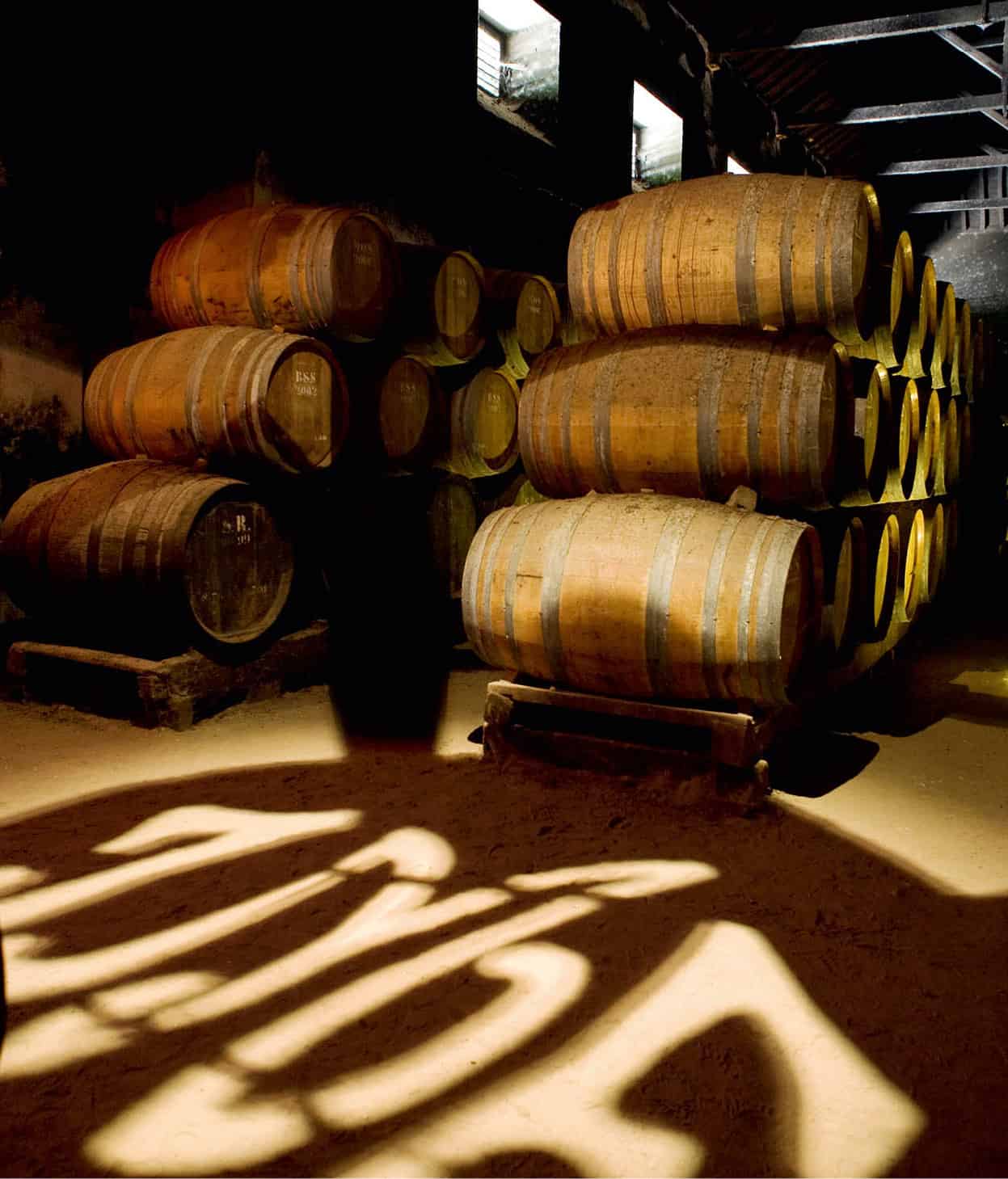
Casks must be tended with skill and care.
Lydia Evans/Apa Publications
Port wine
Port wine begins life in the Upper Douro, a demarcated region whose boundaries cling to the banks of the Douro and its tributaries. A wide variety of grapes grow here: preferred reds include Tinta Roriz, Tinta Francesa (a descendant of the French Pinot Noir), Touriga Nacional and Bastardo; among the whites are Malvasia, Esgana Cão and Rabigato.
The regions producing the finest ports presently centre around Pinhão, some 20km (14 miles) east of Régua, and extend to the Spanish border. The famous shipping firms all have their quintas (manor houses) in the hills of the Douro. It is here that the fermentation process takes place in autumn, interrupted by the addition of grape brandy, to create the raw, fortified wine. Young port then spends the winter at the quinta. In springtime, it is transported to the port lodges (many of which are open to the public) in Vila Nova de Gaia, where it is blended and matured into a variety of styles. It is here that you can learn about and taste the basic differences between ports.
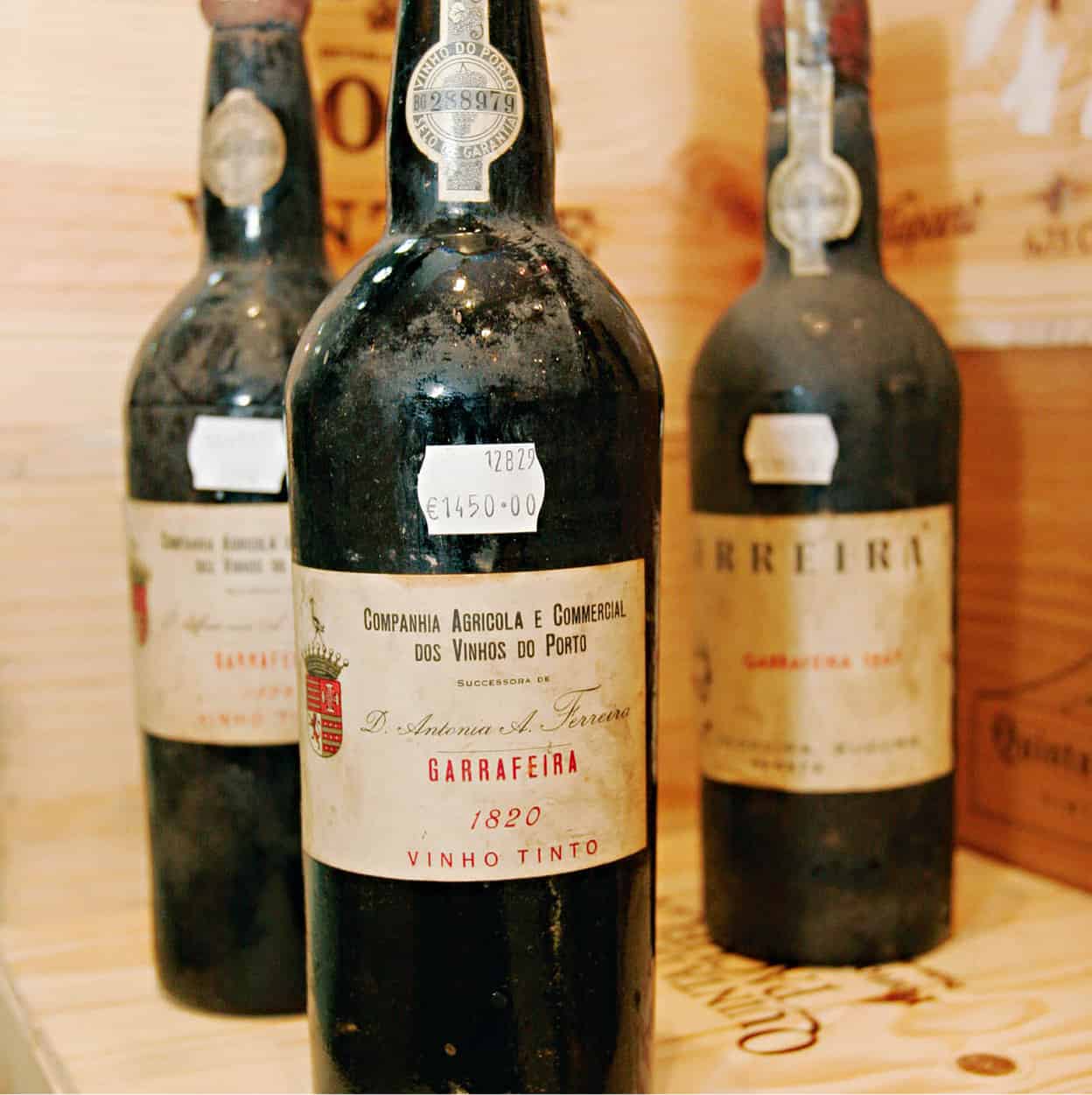
Tawny port is aged in wood for seven years.
Lydia Evans/Apa Publications
One good place to sample various port wines is at the Solar do Vinho do Porto (in Lisbon’s Bairro Alto).
Vintage port
The most famous and most expensive of the ports is the vintage variety. It is produced from the grapes of a single harvest and is “declared” only in years when the quality is deemed extraordinary. Vintage port is bottled after just two or three years in wood. This is what distinguishes vintage from all other ports: the majority of the ageing process takes place in glass, rather than wood. From a legal standpoint, vintage port must identify itself as such – stating the name of its producer and the year of the vintage – and must carry the governmental seal. For example, the great 1963 vintage must, by law, have been bottled between 1 July 1965 and 30 June 1966.
Vintage port may be drunk 10 years after its vintage date, but most wines hit their stride after about 15–20 years. Classic wines were produced in 1963, 1977 and 1994; 2000, 2003 and 2007 are particularly good years. Taylor, Graham, Croft, Noval and Ferreira are some of the best-known among a host of eminent port-wine makers.
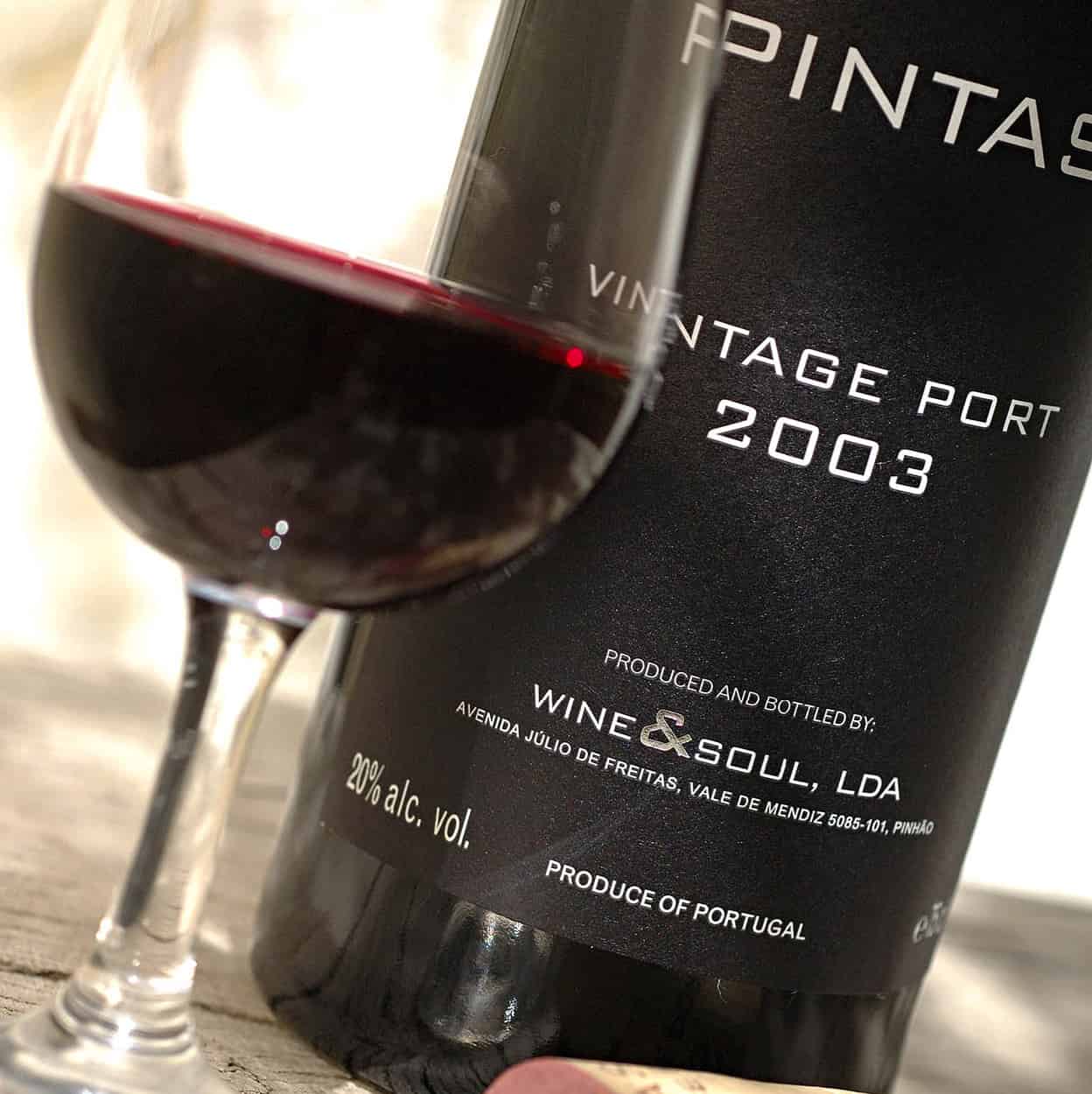
Vintage port wine Pintas by Jorge Borges and Sandra Tavares.
SuperStock
Crusted port
Crusted port differs from vintage port in that its grapes need not come from a single year, or vintage, but is mostly created from two or three different harvests. Crusted port spends extra time in wood, accelerating the maturation process. This extended ageing makes for a lighter-bodied wine. Like vintage port, however, it throws a sediment and needs to be decanted.
Late-bottled port
Late-bottled vintage (LBV) sees even more time in wood – from four to six years. As its name implies, the wine comes from a single year’s harvest, but is much lighter in colour than vintage port and need not be decanted. Both the date of the vintage and the date of bottling must appear on the label. When buying, it is worth remembering that shippers generally do not offer late-bottled vintage in the same years as they offer real vintage port.
Confusing Colheitas
There is a confusing offshoot of the vintage-dated wines, called “Port of the Vintage” or “Port with Date of Vintage”. These wines come from a single year, but will have been aged in wood for no less than seven years. The bottle will often say Colheitas (vintage) and give the year; it will show the date of bottling and some indication that the wine has been aged in wood. The house of Nierport has a wonderful stock of these Colheitas. They are the first step into tawny ports, but the fact that they are from a single vintage prevents them legally being so titled under the strict regulations on port making and marketing.
Wood ports
Wood ports are blended wines – using grapes from several harvests – that are matured in casks until they are ready for drinking. Because they are blended, it is the goal of the shipper to define his style through this wine so that year after year the customer can confidently expect a consistent product. The three main types are ruby, white and tawny.
Ruby is young and hearty and inexpensive. To a port drinker, it is the staple wine, attractive for its full, overt flavour. It is aged for two or three years in cask before bottling. One offshoot of ruby port is called “Vintage Character” port. It will have the same general features but will be of a higher quality, usually older, and more expensive.
White ports are also matured in wood. They can come from either red or white grapes: a clear wine can be obtained from red grapes by separating the juice from the skins during fermentation before the colour has been extracted. Wine-makers have tried to popularise whites by fermenting out the sugar, adding brandy, and marketing them as dry aperitif wines.
Then there is tawny port, a special blend of port wine from different vintages which sees many years in cask. Through the more rapid oxidisation process within the barrel, this wine matures rather more quickly. Tawny port is thus more mellow in style than the “vintage-dated” ports, but it is refined, with a rich tawny colour and fabulously scented bouquet.
Old tawnies are expensive, priced in correlation to the longer ageing period. They should not be confused with the cheap tawny port available abroad, which owes its existence to the demand for a less concentrated but drinkable port wine, which the port shippers have answered by concocting a blend of ruby and white port. The product is a simple wine of pinkish hue, in contrast to the fading russet and complexity of a true tawny. Since the name “tawny” can apply to either wine, the consumer must rely on colour and price to distinguish between the two. Among a wide choice, Ferreira, Noval and Taylor 10-, 20- and 30-year-olds are fine examples of tawny port. Only the “real thing” will reveal why this is the wine which many port houses most prize and which many blenders enjoy as an all-day drink (and have even been seen to add ice cubes to).
Vinho verde country
The lush, green Minho is the country’s oldest and most intensively cultivated wine area, the region of vinho verde. The vine seems to be everywhere – along narrow roads, framing houses with pretty bowers called ramadas, across new, neat plantations of cruzetas, crosses with wire supports a tractor operator can reach.
Not green, as its name suggests, vinho verde is made from fully matured grapes from varieties that include Azal, Trajadura, Alvarinho and Loureiro for the whites, and Brancelho, Pedral and Tinto Cão for the reds. The taste is dry, with many subtle shadings; it is light and refreshing, with an alcohol content of only 8 to 11 percent. The fizz – known as pétillance to wine connoisseurs, agulha to the Portuguese – is not added, but appears naturally during the making.
First, the grapes are fermented to convert their natural sugars into alcohol. Then a secondary fermentation, called the malolactic, takes place. Induced by naturally occurring bacteria, this converts malic acid to lactic; a harsher, rather unpleasant acid into a milder, more palatable one.
While this secondary fermentation is common to wines made in many countries, the vinhos verdes are distinguished by their retention of the fermentation’s by-product: carbon dioxide. From this comes that characteristic sparkle in the wine, which can vary, depending upon age, technique and storage, from a light tingle on the tongue to a spritely carbonation, the hallmark of vinhos verdes.
Notable estate-made vinhos verdes come from more than 50 members of the Association of Producers and Bottlers of Vinho Verde, who must produce wine only from their own grapes (not buy them, as bulk producers do). The result is a range of wines produced in small quantities but with individual characteristics.
Much admired among single-estate wines is the Palácio da Brejoeira vinho verde produced from a single grape variety, Alvarinho, in Monção. It is also the most expensive. You can, though, taste a good, and cheaper, Alvarinho made by the Adega Cooperativa of Monção.
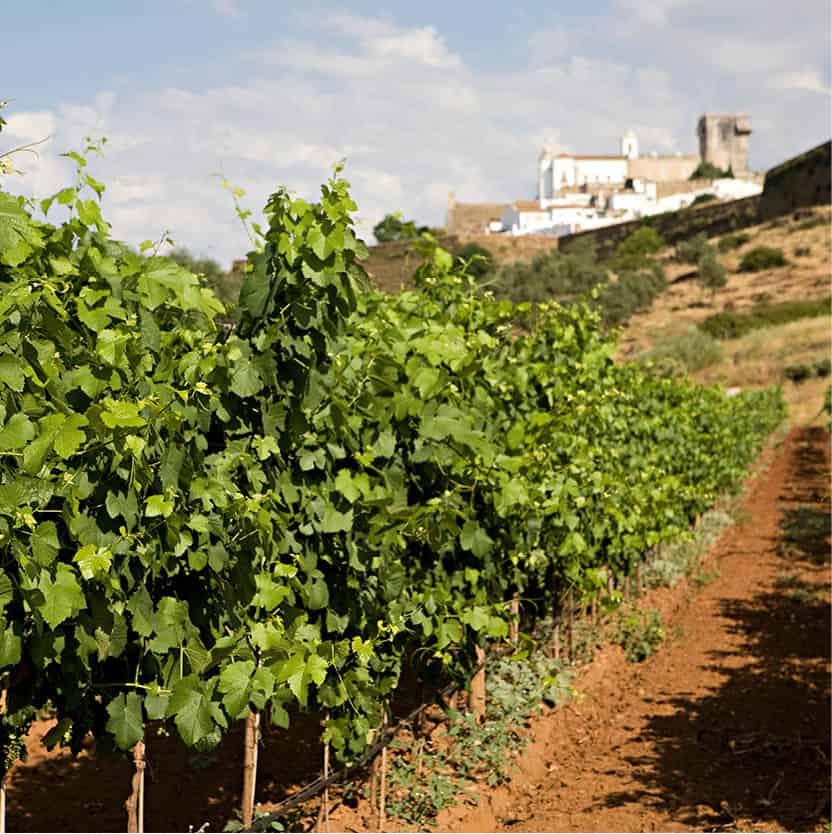
A vineyard in the Alentejo.
Lydia Evans/Apa Publications
“Green wine”
No one knows for sure where the eloquent phrase vinho verde (green wine) originated. One explanation is that it derived from the Minho region’s green landscape, which receives up to 200cm (78ins) of rain a year. Another equally likely explanation is that the name simply refers to the youth or “greenness” of the wine, because it is not allowed to mature in the same way as normal table wines. The fact that vinho verde can be either white or red, and called verde branco (white) or verde tinto (red), introduces an even more colourful note. Whatever the origin of the name, the connotation of a cool, refreshing liquid is appealing.
Wine regions
Truly superb wines, a few eccentric and many sublime, are to be found in Portugal. From the once-cherished Dão area, which in recent years has tumbled from its pedestal, comes Caves São João’s good red Porto dos Cavaleiros (its Reserva among the very best Dão wines) or the Sogrape Dão Reserva; and, from Sogrape’s technologically advanced winery, the old favourites Grão Vasco and Terras Altas. Bairrada, a small area north of Coimbra, has held its reputation for classic wines, more than 80 percent red, mainly from the Baga grape. The whites include a pleasant espumante, or sparkling wine. Good Bairrada wines are made by Sogrape, Messias and Caves Aliança.
For something really special, head for the bizarre and extravagant neo-Manueline Palace Hotel do Buçaco (for more information, click here), which has a stupendous cellar of its own Buçaco wines, dating from the 1920s.
You can also taste perfectly good Bairrada wines at the cluster of down-to-earth roadside restaurants that can be found in nearby Mealhada, all offering the local speciality, leitão, suckling pig.
The Douro is the source of many of Portugal’s finest table wines (even in the port region only 40 percent of the grapes go into port). Ferreira, a distinguished port-wine producer, also makes the renowned Barca Velha, probably the finest of all Portugal’s red wines. Other Ferreira reds include their Reserva Especial or the more accessible Esteva. Top-ranking Douro wines include those under the Quinta do Cotto label – Grande Escolha is one. As in other areas, Sogrape are conspicuous – Planalto is just one of their good Douro wines. Adriano Ramos Pinto produce the really excellent Duas Quintas red.
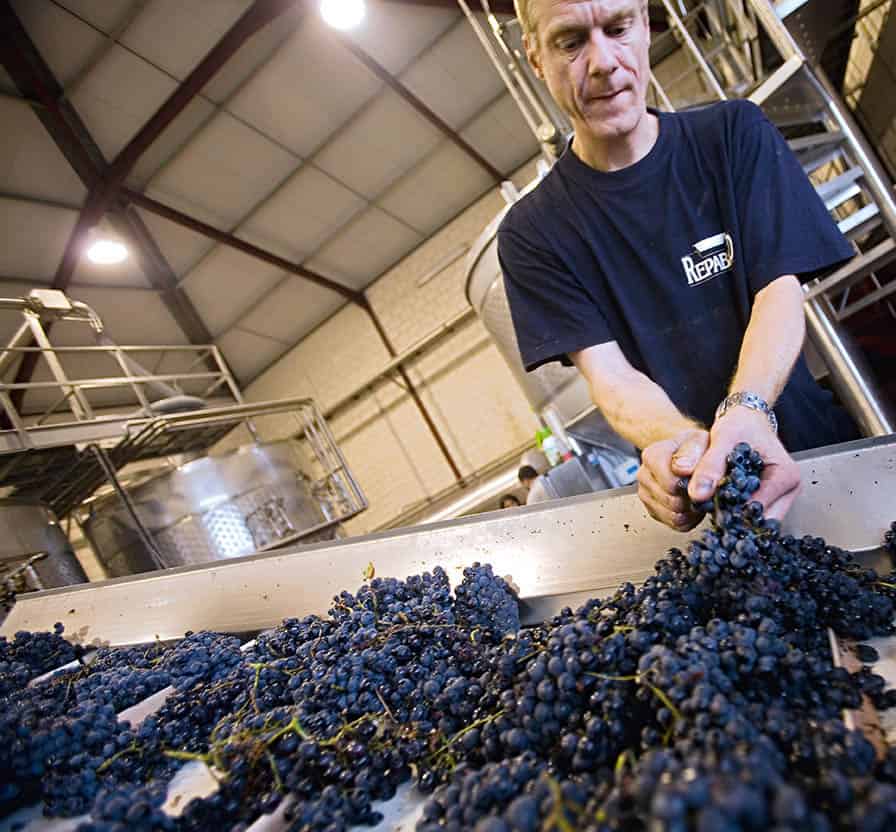
Processing the grapes.
AWL Images
Closer to the capital
From nearer to Lisbon comes a variety of good wines – the white from Bucelas is a consistent favourite. Pleasant wines, too, come from the Colares area, just beyond Sintra.
To the south of Lisbon two major wineries, confusingly with very similar names, are in Azeitão, near Setúbal (both are open to the public). One, José Maria da Fonseca, makes a very popular red, Periquita, and the excellent dry Branco Seco. If you care for sweet muscatel dessert wines, you might like to try the Moscatel de Setúbal. The second, more modern winery is J.M. Fonseca International, widely known for its very successful Lancer’s red, white and rosé, sold in their distinctive clay jars.
Two eminent wines from the Setúbal area are João Pires, and the deep red from the Quinta de Bacalhoa, both developed by the skills of Australian oenologist, Peter Bright, who has lived in Portugal since 1982, and founded the Terras de Alter winery in the Alentejo in 2004.
Wines from Portugal’s southernmost province, Algarve, are largely table wines, consumed on the spot, but they should not be dismissed and many are improving.
A range of good-quality wines is made in the eastern Alentejo in such towns as Borba, Reguengos and Vidigueira, which produce a very good white reserva. Look, too, for the deep-red and distinctive Esporão. In many good Lisbon restaurants you are very likely to be recommended an Alentejo red, rather than the more usual white, if you choose any variety of bacalhau (salt cod).
Port dynasties
In a technological age there are few trades where heritage and family ties are a matter of pride, but port is one of them.
Port has its roots in the wild upper reaches of northern Portugal’s Douro valley, a wine region that has had virtually the same frontiers since the Marquês de Pombal defined them in 1756. At the time, the reforming Pombal, who felt a hearty dislike for the British and their leading role in Portuguese trade, was determined to restrict the hold they had had on the area ever since the Methuen Treaty of 1703 had established their dominance of the industry. In subsequent centuries, port has improved immeasurably in quality and the profits are more evenly spread. But although snobbish exclusivity is long gone, the British are still very much part of the port scene.
The British affinity with port
The British association with port is long and eventful – although these days the French buy more. British buyers enthusiastically explored the Douro valley in the 17th century. George Sandeman instructed the Duke of Wellington’s troops on the finer points of port. One of the pioneers, cartographer Joseph James Forrester, a Scot, fought tirelessly for high standards and mapped every centimetre of the Douro River. He was made a baron in 1855 for his efforts. It was regarded as a national tragedy when, in May 1862, Forrester’s boat overturned and he drowned in the Douro. He was travelling between various wine-growing quintas, paying the farmers in gold coins, and it is said that it was his money belt, heavy with gold, which helped to drag him down.
A survivor of the tragedy was another personality in the saga of port: Dona Antónia Adelaide Ferreira, whose vineyards covered huge areas of the Douro.
These and other colourful characters are familiar to everyone in the business. The founders of the port-wine trade are ever-present, their faces and names on port-wine labels. Many rival companies have inter-family links. Their names, however, can be deceptive: for all its English ring, Cockburn Smithes has had a Portuguese managing director for many years.
Generations of family firms are at the core of the port-wine business and their names provide lustre to superb wines. But in the nature of business, companies change. The Taylor, Fladgate & Yeatman group, including the much-esteemed Guimaraens, became the Fladgate Partnership. The historic Casa Ferreirinha is owned by multi-armed Sogrape. Cockburn Smithes in 2006 entered the embrace of the renowned family firm of Symington.
The name of Symington has been inescapable since the 1800s. The family owns and manages a distinguished list: Warre’s (founded in the 1670s), Silva & Cosens (whose brand is Dow), Quarles Harris, Smith Woodhouse, and Graham’s. In the 1990s two generations and eight members of the Symington family were still involved in management, production, sales and marketing of the fine ports made by these independent companies. The family has, more recently, become prominent in promoting the re-emergence of much underrated Madeira wine.
The wine shippers still meet at lunch on Wednesdays in the Feitoria Inglesa or “English Factory House” in Porto to discuss business and sample a good vintage following the meal.
Efficient modern methods are used in the wine industry these days, but technology blends smoothly with tradition. Even the Symingtons’ Gaia offices hold echoes of port’s memorable past: they are in Travessa do Barão Forrester, in the very house where Baron Forrester once lived.
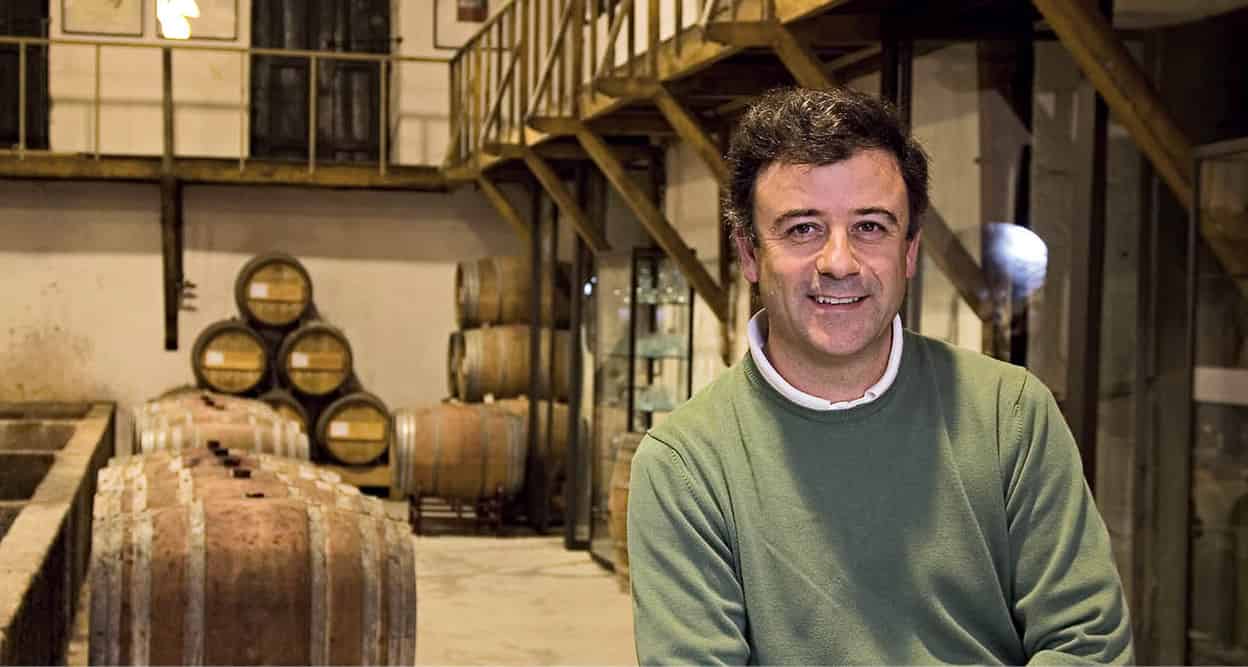
Mateus Estate, near Vila Real, Douro area.
SuperStock